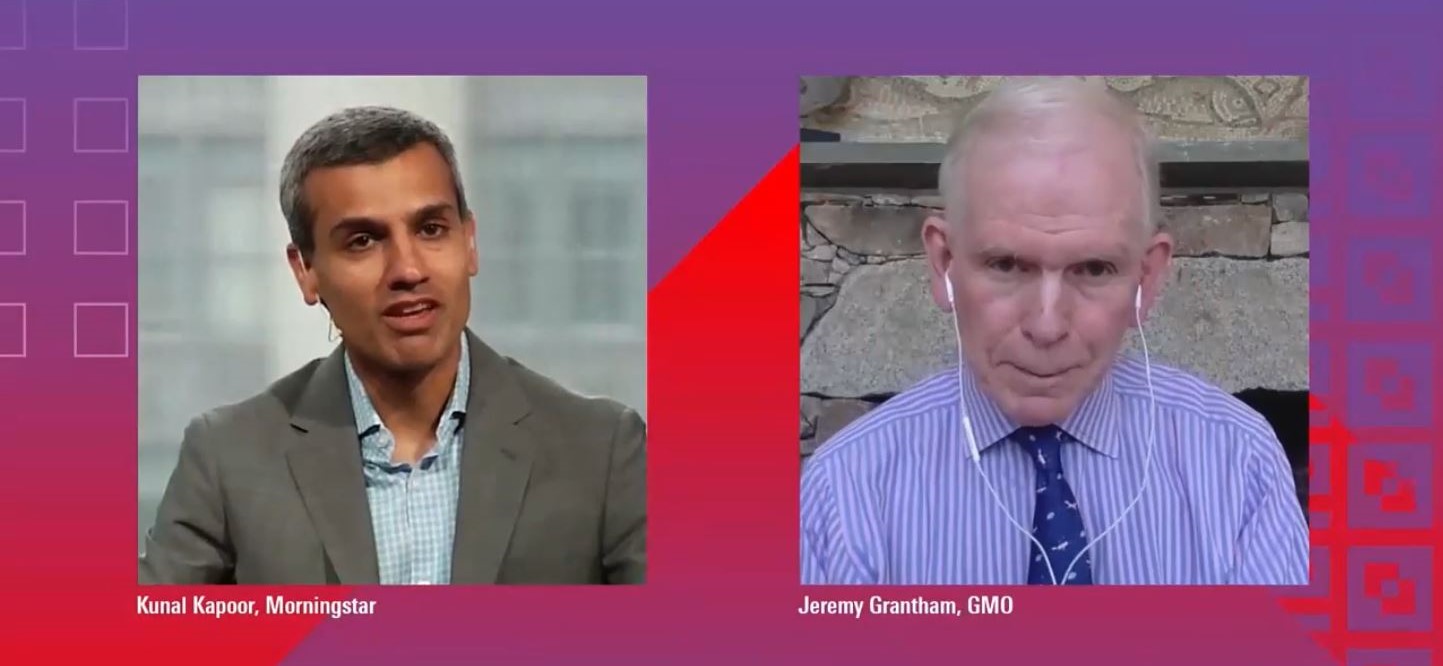Jeremy Grantham co-founded GMO in 1997 and is a member of its Asset Allocation team, serving as the long-term investment strategist. He was interviewed by Kunal Kapoor, CEO of Morningstar, at the Morningstar Investor Conference Australia on 2 June 2021.
JG: Having high-priced assets is great for retirees and old folks like me, for selling off my assets, but for everybody else, it means you compound your wealth more slowly. And if you don’t have any wealth, you pay twice what your parents paid for a house, you pay twice for a portfolio in the sense that you get half the yield. It’s a fairly miserable world so I welcome lower asset prices which I’m confident will come from these very high prices, even a modest retracement back towards the last 100-year average. If it went back halfway, there’s a major bear market.
And the other thing we have to watch is, if you’re going to have a bubbling market, make sure you only do it in one major asset class. Don’t pull a Japan. Japan had the biggest bubble in history in land and real estate, bigger than the South Sea Bubble in my opinion. It also had the biggest equity bubble of any advanced country. Pulling two at the same time means 32 years later, their land is not back to where it was in 1989, and the stock market is not back in nominal dollars to where it was in 1980.
And that’s a perfect example as the higher you go, the longer and greater the fall. Japan had never sold at over 25 times earnings before and at the time, it was 65 times. That’s a pretty hefty new high, from 25 to 65.
And the same in 2000. We had never sold over 21 times earnings and then the tech bubble took us to 35 and 10 years later, we were selling at a lower price. And that’s how it works. You can’t get blood out of a stone. You can have a high-priced asset or a high-yielding asset, but you can’t have both at the same time.
KK: What do you think some of the triggers might be that could lead to this reassessment of the valuation of different asset classes?
JG: Well, they’re still arguing about what caused the 1929 crash. We have not been good at identifying causes and it may be because there is no traditional pin to pop the bubble. The market hits its all-time high when optimism is at an absolute peak. And the following day, is the second-most optimistic day in history, but it’s a shade less optimistic than it was yesterday, and the price begins to fall a little bit.
It won’t take bad news, it won’t take a thoroughly bad economy. It will take a perfectly good economy and perfectly optimistic outlook, but a little less than it used to be a week ago, a month ago. And in 2000, we saw the really optimistic crazies, the pet.coms, peel off in March of 2000. The rest of the market shrugged them off as crazies and the market kept rising, and then they peel through the growth stocks and finally they shot Cisco which for eight seconds was the biggest company in the world by market cap.
By September, the 30% of the market that had been growth was down 50% but the S&P was unchanged. The rest of the market had continued to rise by 15%, and then the termites, the optimism termites or the pessimism termites, would be a better description, finally got to the balance of the market and the whole 70% rolled over and dropped 50% in two years.
What do we see this time? The super crazies are anything to do with electrification, EV for sure. Tesla is the king of that route, and the SPACs (Special Purpose Acquisition Companies) and the intersection whether EVs or batteries and so on. It was perhaps the most outstanding degree of enthusiasm and the SPAC index is down 30%.
KK: So amidst that big picture where we’re in a unique time with unique asset prices, interest rates low, debt high, debates around whether inflation is going to be real or not, are there any pockets that you think are interesting from an asset class perspective? Where you think people can earn a decent return, or do you feel you’re going to have to just be defensive for a long time?
JG: It’s closer to that. 2000 was brilliant, though. Bonds were incredibly cheap, TIPS (inflation-linked bonds) yielded 4%, real estate sold below replacement costs. You don’t want to pull a Japan, and we tried to in 2008. We had a genuine housing bubble in America, a three sigma, one-in-100-year event, and it sucked the equity market with it. The housing market went all the way back to trend line and it took the S&P down 50% with it.
And those two combined packed a much bigger punch to the economy than had the tech bubble in 2000. And 2008 also had oil and commodities spiking in 2007 so they inflicted quite a lot of pain on consumer income and that made the recession even worse. This time, real estate is suddenly pretty bubbly in almost every interesting market in the world. I have to say, notably including Sydney, but also Vancouver, London, Paris, New York, San Francisco all over, and our housing market is up 15% in the last year. You can’t have an asset class like housing, where the house doesn’t change and you’re just marking it up in real terms, year after year. Eventually, there’ll be a day of reckoning.
And remember, the higher the multiple of family income, the longer and the bigger the pain is likely to be based on Japan and on the US. So real estate almost everywhere on the planet has doubled in price and halved in yield. The bond market, as Jim Grant would say, is the highest in the history of man. We have records going back to the Babylonians, and there’s never been these kinds of negative real rates. And then it comes to equities, where it isn’t so much global as the US.
The developed world is merely overpriced, no big deal on its own, but the US is heroically overpriced and emerging markets is actually fairly cheap. Then within the structure of equities, value managers have had a brutal 11 years. It was the worst 10 years in history for value versus growth, and then last year was by far the worst single year. Value is certainly as cheap as it has ever been against growth, and there are signs over the last few months that it has shifted.
If you look at the intersection of these two ideas, emerging markets and value, I have complete confidence that if you bought the intersection – cheap emerging market stocks – then you would get a perfectly handsome 10- or 20-year return. And I am pretty darn confident that you will not get a handsome 10-year return from say the S&P 500 or NASDAQ. NASDAQ peaked two months ago, and is now up 5% versus the S&P’s 12%.
Remember, it has a higher beta. When high beta stocks start to underperform, you want to watch out. In 1929, the flaky, junky high beta stocks underperformed the whole year so badly that they were down year-to-date the day before the crash. They did the same in the Nifty50 era of 1972. The S&P was up 17% while the average big board stock was minus 17, nice symmetry. And then in 2000, as I said, all the growth stocks went down, and the rest of the market went up for eight months. And this time, my guess is the super SPACs peaked in January, the NASDAQ peaked in February, and maybe in a few months, the termites will get into the rest of the market.
KK: I want to ask you a simple question around the surge in commodity prices where any significant commodity is at multi-year highs. What’s your view and what’s going on and is it sustainable? Obviously for investors in Australia, it’s a very important topic.
JG: I think there was a paradigm shift. We had gone from 100 years of irregularly falling prices, yes, they go up in World War One and World War Two and the oil crisis, but in between they kept coming down. So over 100 years, they lost 70% of their real value. Then from 2000 to 2008 and then in 2011, prices bounced up without anyone getting too excited, mainly due to China. That created a new era where we’ve kind of entered the end game, where instead of prices routinely falling in the long term, some will rise, some will fall, some will be flat, and you just have to get used to the fact that it’s not a tailwind (for the economy) any longer.
There is no way copper will not rise hugely from here because of the electrification of everything. And that goes for cobalt, that goes for lithium, and all of the metals except iron and aluminium are really scarce. We’ve done a pretty good job over 200 years of mining out the really high-grade ores everywhere. There’s a lot of aluminium, there’s a lot of iron ore, you may have squeezes like we have today from time to time but in the end, there’s plenty, but everything else is really, really scarce.
You have to be reconciled in the long run for a different world of commodity prices, but what that means for the next two years, I leave to other people.
KK: A lot of what you’ve been laying out (in the past about climate change) obviously makes sense if you’re overseeing a large pool of money and you’re allocating assets and you have access to all kinds of information and data that allows you to make some of these decisions. What do you think an effective decision making and implementation framework might be for a financial adviser or an individual investor who’s starting to think about these issues? If they want to make a shift in their portfolios to reflect valuations and climate change and some of its effects. How can folks individually start to make a difference?
JG: They can make a difference by buying climate change funds. I’m happy to say GMO has a pretty good one. ESG funds, where many reputable firms have them, that would make a difference. It would be good if we had a better rating on all the funds voting records to see how green they are.
Let me just say a word about the Grantham Foundation because we have a completely different investment approach. We decided that American capitalism seems to be past its prime, a little fat and happy, not aggressive enough. There’s only half the number of people working for firms one- and two-years-old as there were in 1975. So we’re losing some of our dynamism, but there is one thing where the US is still exceptional and that is venture capital. Venture capital is really attracting the best people these days, they don’t go to Goldman Sachs to write algorithms, they go into venture capital or to start a new firm.
Venture capital is not like private equity. It’s not institutional investing. In the end, we have to admit we’re playing a cosmic poker game. We (GMO) are trying to beat the other players, and it’s fun, but we’re not really creating value. Venture capital is, we’re causing firms to exist that otherwise would not exist. We’re raising money for them, and in some cases, some of us are giving good advice to them. But America does that very well and we decided in our Foundation to go for broke. We are aiming to put 70% of everything we have into early-stage VC, of which half is in green early-stage VC, and we have our own team doing that. Thoroughly exciting Boston is a great place to do that, we started more new
ventures last year than San Francisco.
It’s just amazing what new technologies are out there. Microbes that will sequester nitrogen in the ground. Batteries that will last twice as long and weigh half as much and won’t burst into flames. The list is completely endless. And the challenge is endless, so this is going to be where all the opportunities are.
The FANG-type companies are what separates the US stock market from the rest of the world, and not so much the P/E as the earnings. Most of the outperformance of the US market in the last 10 years has come from extra earnings, and over 80% of those extra earnings have come from this handful of FANGs. They have sprung out of the venture capital industry. They are a classic demonstration of that pool of venture capital 20 to 50 years ago, these are some of the winners that have become global giants, bone crushing in their competence and competitive spirit. And I think that that will continue, and it will be a true advantage for the American system.
This is an edited transcript by Graham Hand, Managing Editor of Firstlinks. A full transcript and video of the interview will be added as soon as it is available. This article is general information and does not consider the circumstances of any investor. Any Morningstar ratings/recommendations contained in this report are based on the full research report available from Morningstar.
 Morningstar
Morningstar





